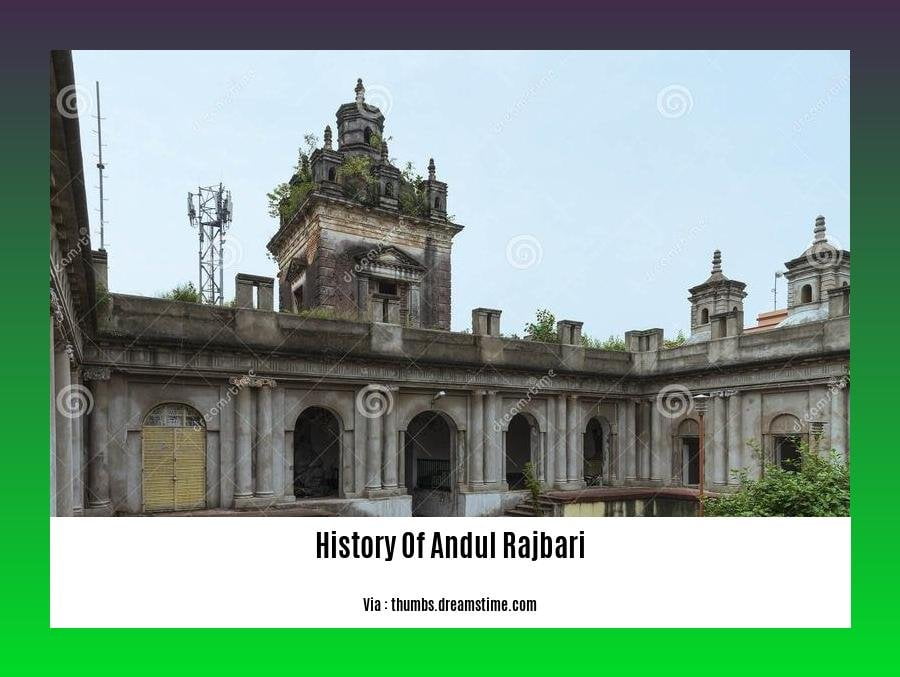Embark on a captivating journey through time as we delve into the rich history of Andul Rajbari, a magnificent architectural masterpiece that stands as a testament to Bengal’s glorious past. Steeped in grandeur and intrigue, the story of Andul Rajbari unfolds like a tapestry woven with threads of cultural heritage, political power, and architectural brilliance. Join us as we explore the fascinating narrative of this iconic landmark and discover the secrets it holds within its walls.
Key Takeaways:
Andul Rajbari is a magnificent palace or heritage site located near Kolkata in Andul, Howrah district, West Bengal, India.
Established in 1834, it was the brainchild of Raja Rajnarayan Raybahadur, a descendant of the illustrious Ramlochan Roy, who held the prestigious position of Dewan to both Lord Clive and Warren Hastings.
Today, the rajbari stands as a testament to its former grandeur and is open to the public as a tourist attraction, offering visitors a glimpse into the captivating history of the Andul royal family, while showcasing the architectural marvels that make this site a true gem.
History of Andul Rajbari

Andul Rajbari stands as a testament to Bengal’s rich architectural heritage, a majestic palace that has witnessed the rise and fall of dynasties, the ebb and flow of history. Immerse yourself in the captivating history of Andul Rajbari, a journey through time that unveils the grandeur of a bygone era.
The Genesis of a Legacy:
Established in 1834 by Raja Rajnarayan Raybahadur, Andul Rajbari’s roots trace back to Ramlochan Roy, a prominent figure who served as the Dewan of Lord Clive and Warren Hastings, two influential British administrators.
A Royal Abode Steeped in Heritage:
The Rajbari served as the palatial residence of the Andul royal family. It is a testament to their affluence and地位, a symbol of their influence in the region.
A Fusion of Architectural Styles:
Andul Rajbari showcases a harmonious blend of architectural influences. Its structure blends traditional Bengali with European elements, a reflection of the cultural exchange that characterized the era.
An Enduring Symbol:
Today, the Rajbari stands as a proud symbol of Bengal’s architectural heritage, a heritage site that draws visitors from afar, eager to witness its grandeur and immerse themselves in its history.
A Legacy Preserved:
Preserved and maintained with great care, Andul Rajbari offers a glimpse into the lives of the royalty who once dwelled within its walls, an opportunity to connect with a past that continues to inspire and enchant.
Embark on a Journey Through Time:
Unveil the rich tapestry of Andul Rajbari’s history, explore its architectural wonders, and let its stories transport you to a time when royalty reigned and history unfolded within its walls.
Want to know more about the relation of Bangladesh with the World’s civilization? Dive into this history of Bangladesh and world civilization to find out more!
Do you know about the rich history of Bohol? Discover the untold stories of this fascinating island in this intriguing article on the history of Bohol.
References[edit]

The history of Andul Rajbari is meticulously documented through various sources, each offering unique insights into the grandeur of this architectural marvel. Among the most notable references are:
Andul Rajbari – Wikipedia:
This comprehensive Wikipedia article provides a detailed overview of the history, architecture, and cultural significance of Andul Rajbari. It includes information on the royal family, construction, and the current status of the palace as a tourist destination.Andul Rajbari and Annapurna Temple: A heritage drive from Kolkata – Ghumakkar: The Travelling Companion:
This travel blog offers a firsthand account of a visit to Andul Rajbari, capturing the essence of its rich history and architectural beauty. The blog provides vivid descriptions, anecdotes, and practical tips for planning a trip to this heritage site.
Key Takeaways:
Andul Rajbari was established in 1834 by Raja Rajnarayan Raybahadur, a descendant of Ramlochan Roy, who served as the Dewan to Lord Clive and Warren Hastings.
The Rajbari showcases a unique blend of Hindu and European architectural styles, reflecting the eclectic influences of its time.
The palace is renowned for its intricate carvings, elegant chandeliers, and grand staircases, which offer a glimpse into the opulence of the Andul royal family.
Andul Rajbari is not only a historical landmark but also a symbol of Bengal’s rich cultural heritage, attracting visitors from far and wide.
The palace has been featured in numerous historical accounts, travelogues, and literary works, cementing its place in the annals of Bengal’s architectural legacy.
History of Andul Rajbari in English
Nestled on the banks of the Hooghly River in Andul, West Bengal, Andul Rajbari stands as a testament to Bengal’s architectural heritage. Built in 1834 by Raja Rajnarayan Raybahadur, a descendant of Ramlochan Roy, Dewan of Lord Clive and Warren Hastings, this palatial mansion is a captivating blend of Hindu and European architectural styles.
The grandeur of the Rajbari is evident in its intricate carvings, intricate chandeliers, and sweeping staircases, showcasing the opulence and artistry of the Andul royal family.
The Andul Rajbari offers a glimpse into Bengal’s past through its rich collection of artifacts, including paintings, weapons, and furniture. These treasures provide a tangible connection to the lives and traditions of the royal family and the region’s history.
Beyond its architectural and historical significance, the Rajbari serves as a hub for cultural events, exhibitions, and workshops, fostering a vibrant cultural scene in Andul.
Key Takeaways:
Andul Rajbari, established in 1834, blends Hindu and European architectural styles.
The grandeur of the palace reflects the opulence of the Andul royal family.
The Rajbari houses a collection of artifacts, offering insights into Bengal’s history.
It serves as a venue for cultural events, preserving and promoting Bengal’s heritage.
Sources:
- Andul Rajbari, Howrah: The End of an Era
FAQ:
Q1: What is the significance of Andul Rajbari in the history of Bengal?
A1: Andul Rajbari holds immense significance in the history of Bengal as a testament to the architectural prowess and cultural heritage of the region. It showcases a unique blend of Hindu and European architectural elements, reflecting the diverse influences that shaped Bengal’s cultural landscape.
Q2: Who was the founder of Andul Rajbari, and what was their role in Bengal’s history?
A2: Raja Rajnarayan Raybahadur, a descendant of Ramlochan Roy, was the founder of Andul Rajbari. Ramlochan Roy served as the Dewan of Lord Clive and Warren Hastings, playing a pivotal role in the administration of Bengal during British rule.
Q3: What architectural features make Andul Rajbari a notable example of Bengali architecture?
A3: Andul Rajbari stands out for its intricate carvings, sculptures, and frescoes, which showcase the exceptional craftsmanship of Bengali artisans. The融合了印度教和欧洲的建筑元素的建筑风格further enhances its architectural significance.
Q4: How has Andul Rajbari contributed to the cultural and historical identity of the region?
A4: Andul Rajbari serves as a repository of Bengal’s rich cultural heritage. It houses a collection of artifacts, including paintings, weapons, and furniture, providing valuable insights into the lifestyle and traditions of the Andul royal family. The rajbari also hosts cultural events, exhibitions, and workshops, contributing to the preservation and promotion of Bengal’s cultural legacy.
Q5: What is the current status of Andul Rajbari, and how can visitors experience its historical charm?
A5: Andul Rajbari is now open to the public as a heritage site and popular tourist destination. Visitors can explore the grand architecture, marvel at the intricate artwork, and learn about the fascinating history of the Andul royal family. Guided tours are available to provide deeper insights into the rajbari’s significance and stories.
- Green Natural Sandstone: Eco-Friendly Building Solutions - April 19, 2025
- Red Cross Flag: Protecting Humanity Through History - April 19, 2025
- China II Review: Delicious Food & Speedy Service - April 17, 2025
















